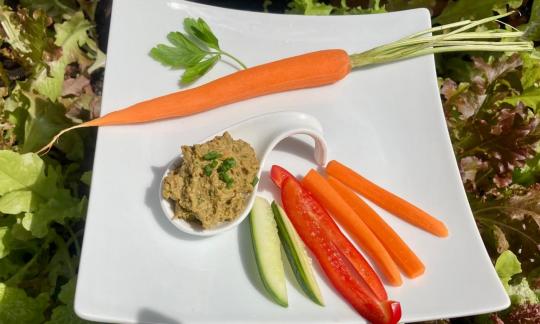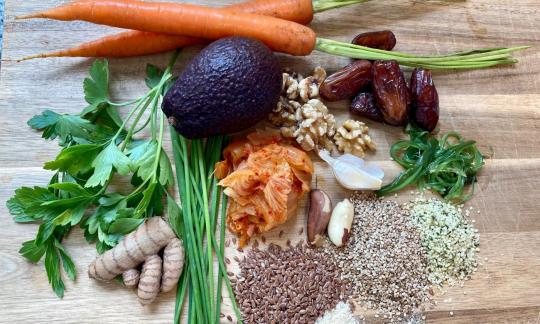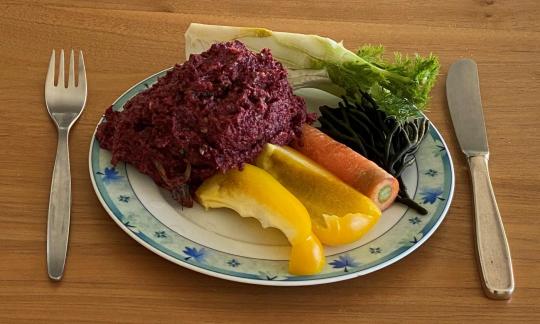Erb-Mix Daikon-Kimchi
raw-vegan
Ingredients (for servings, )
| For the Daikon Kimchi | |
|---|---|
| ⅓ oz | Sesame, raw, unpeeled (sesame seeds, organic?) |
| ⅓ oz | Linseed, raw, organic? (golden linseed, flax) |
| ⅓ oz | Hemp seeds, peeled, raw (organic?) |
| 1 ¾ oz | Kimchi made from cabbage or radish (raw?, organic?) |
| 1 clove | Garlic (organic?) (0.11 oz) |
| ¼ oz | Turmeric, fresh (raw, organic?) |
| 6 | Dates, variety Deglet Nour, pitted, raw?, (organic?) (1.5 oz) |
| ⅓ oz | Walnuts (tree nuts), raw (organic?) |
| 2 | Brazil nuts, raw? (organic?) (0.18 oz) |
| 4 ⅓ oz | Avocados, raw (organic?) |
| 1 dash | Black pepper (organic?, raw?) (0.00 oz) |
| ⅛ oz | Yeast flakes: noble yeast, nutritional yeast, yeast powder (raw?, organic?) |
| oz | Wakame, getrocknet (bio?) |
| ⅛ oz | Chives, raw (organic?) |
| ⅛ oz | Parsley, fresh, raw (leaf parsley, parsley) |
| for dipping | |
| 4 ⅓ oz | Carrots (carrots), raw (organic?) |
| 3 ½ oz | Cucumbers, raw (organic?) |
| 5 ½ oz | Sweet peppers, red, raw (organic?) |
Equipment
- hand-held blender / immersion blender or blender
- coffee grinder, electric or shredder
- nutcracker
Type of preparation
- chop or grind
- food preparation without heating
- blend
- remove the skin
Preparation
Prepare the Daikon Kimchi with the Erb Mixture
Put sesame seeds, flax seeds and hemp seeds together in an electric coffee grinder or food processor and grind finely.Chopping allows better access to the nutrients.
Put the kimchi in a suitable bowl. Peel the garlic and chop finely, peel the turmeric and cut into small pieces, chop the dates and put everything in the bowl.
Chop the nuts (walnuts, Brazil nuts) and add to the rest along with the avocado, pepper, yeast flakes and wakame - or just 1 g of dried wakame per person. Finely chop the herbs (chives, parsley), add them too and chop everything with a hand blender or blender.
It is sufficient if your hand blender has a power of about 400-600 watts.
To chop the nuts, you can wrap them in a towel and work them with a hard object (e.g. hammer) on a suitable surface.
Alternatives: lettuce ( romaine lettuce, Batavia lettuce, lamb's lettuce orhead lettuce) or beetroot.
Prepare and serve dip
Cut the carrots or other vegetables into thin strips and serve with the pea mixture daikon kimchi.Alternatives for dipping: In addition to carrots, you can also use peppers ( red, yellow or green peppers), cucumbers or celery sticks (celery stalks) cut into pieces to make dipping sticks.
|
Nutritional Information per person
Convert per 100g
|
2000 kcal | |
|---|---|---|
| Energy | 361 kcal | 18.0% |
| Fat/Lipids | 22 g | 30.8% |
| Saturated Fats | 2.9 g | 14.3% |
| Carbohydrates (inc.dietary fiber) | 40 g | 14.8% |
| Sugars | 21 g | 23.8% |
| Fiber | 13 g | 53.1% |
| Protein/Albumin | 9.5 g | 19.0% |
| Cooking Salt (Na:213.1 mg) | 541 mg | 22.6% |
| Essential micronutrients with the highest proportions | per person | 2000 kcal | |
|---|---|---|---|
| Vit | Vitamin C (ascorbic acid) | 113 mg | 141.0% |
| Fat | Alpha-Linolenic acid; ALA; 18:3 omega-3 | 2.2 g | 109.0% |
| Vit | Vitamin B1 (Thiamine) | 1.2 mg | 108.0% |
| Min | Selenium, Se | 53 µg | 96.0% |
| Vit | Vitamin K | 64 µg | 86.0% |
| Vit | Vitamin A, as RAE | 646 µg | 81.0% |
| Vit | Vitamin B9, B11 (Folate, as the active form of folic acid) | 150 µg | 75.0% |
| Min | Iod, I (Jod, J) | 113 µg | 75.0% |
| Min | Copper, Cu | 0.71 mg | 71.0% |
| Min | Manganese, Mn | 1.3 mg | 65.0% |
Detailed Nutritional Information per Person for this Recipe
The majority of the nutritional information comes from the USDA (US Department of Agriculture). This means that the information for natural products is often incomplete or only given within broader categories, whereas in most cases products made from these have more complete information displayed.
If we take flaxseed, for example, the important essential amino acid ALA (omega-3) is only included in an overarching category whereas for flaxseed oil ALA is listed specifically. In time, we will be able to change this, but it will require a lot of work. An “i” appears behind ingredients that have been adjusted and an explanation appears when you hover over this symbol.
For Erb Muesli, the original calculations resulted in 48 % of the daily requirement of ALA — but with the correction, we see that the muesli actually covers >100 % of the necessary recommendation for the omega-3 fatty acid ALA. Our goal is to eventually be able to compare the nutritional value of our recipes with those that are used in conventional western lifestyles.
| Essential fatty acids | per person | 2000 kcal |
|---|---|---|
| Alpha-Linolenic acid; ALA; 18:3 omega-3 | 2.2 g | 109.0% |
| Linoleic acid; LA; 18:2 omega-6 | 6.4 g | 64.0% |
| Essential amino acids | per person | 2000 kcal |
|---|---|---|
| Tryptophan (Trp, W) | 0.11 g | 43.0% |
| Threonine (Thr, T, irreversibly transaminated) | 0.40 g | 43.0% |
| Isoleucine (Ile, I) | 0.34 g | 27.0% |
| Valin (Val, V) | 0.43 g | 26.0% |
| Phenylalanine (Phe, F) | 0.39 g | 25.0% |
| Leucine (Leu, L) | 0.56 g | 23.0% |
| Lysine (Lys, K, irreversibly transaminated) | 0.38 g | 21.0% |
| Methionine (Met, M) | 0.19 g | 20.0% |
| Vitamins | per person | 2000 kcal |
|---|---|---|
| Vitamin C (ascorbic acid) | 113 mg | 141.0% |
| Vitamin B1 (Thiamine) | 1.2 mg | 108.0% |
| Vitamin K | 64 µg | 86.0% |
| Vitamin A, as RAE | 646 µg | 81.0% |
| Vitamin B9, B11 (Folate, as the active form of folic acid) | 150 µg | 75.0% |
| Vitamin B6 (pyridoxine) | 0.76 mg | 54.0% |
| Vitamin B5 (Pantothenic acid) | 1.7 mg | 29.0% |
| Vitamin B2 (Riboflavin) | 0.39 mg | 28.0% |
| Vitamin B3 (Niacin) | 4.4 mg | 28.0% |
| Vitamin E, as a-TEs | 3.2 mg | 26.0% |
| Vitamin B7 (Biotin, ex vitamin H) | 8.6 µg | 17.0% |
| Essential macroelements (macronutrients) | per person | 2000 kcal |
|---|---|---|
| Potassium, K | 1'109 mg | 55.0% |
| Magnesium, Mg | 157 mg | 42.0% |
| Phosphorus, P | 291 mg | 42.0% |
| Sodium, Na | 213 mg | 27.0% |
| Calcium, Ca | 148 mg | 18.0% |
| Essential trace elements (micronutrients) | per person | 2000 kcal |
|---|---|---|
| Selenium, Se | 53 µg | 96.0% |
| Iod, I (Jod, J) | 113 µg | 75.0% |
| Copper, Cu | 0.71 mg | 71.0% |
| Manganese, Mn | 1.3 mg | 65.0% |
| Iron, Fe | 3.8 mg | 27.0% |
| Zinc, Zn | 2.4 mg | 24.0% |
| Fluorine, F | 11 µg | < 0.1% |
The Erb Daikon-Kimchi mix is particularly healthy and covers many micronutrients, including the daily requirement of selenium and iodine.
Nutrient profile: According to GDA guidelines, one portion covers more than the average daily requirement of omega-3 fatty acids. Copper, iodine and selenium are also covered and the manganese requirement is over 90%. In terms of vitamins, this recipe provides you with enough thiamine (vitamin B1) and also provides over 50% of the daily requirement of the vitamins folate (folic acid), vitamin K and vitamin A. The ratio of omega-6 to omega-3 fatty acids is 4:1, even better than the recommended ratio of 5:1. More on this under: Vegans often eat unhealthily. Avoidable nutritional errors.
Kimchi: This Korean vegetable preparation, usually made through lactic acid fermentation, is based on cabbage (traditionally Chinese cabbage) or radish (eg daikon radish). It is often available fermented and raw - its taste depends greatly on the method of preparation and its ingredients. Kimchi is best kept in the refrigerator; the longer you store kimchi, the more intense and sour its taste becomes.
Brazil nuts: The Brazil nut is often not raw, but blanched. In addition to a high protein and fat content, it also has a very high mineral content compared to other types of nuts, especially selenium, which is important for our bodies. By eating one to a maximum of four Brazil nuts from Bolivia per day, the daily selenium requirement can easily be covered. You can find out more in our recipe: " Daily selenium requirement (selenium): Brazil nut ".
Wakame: Is a brown seaweed with a slight sea taste and a lot of iodine and can be eaten raw or cooked. For more information about iodine and a comparison of different types of seaweed, see our nutritional information on iodine, I (iodine, J). By adding seaweed, as here with wakame, the daily iodine requirement can easily be covered if you do not use iodized table salt, but live in an iodine-poor area (many parts of Europe) and eat mainly locally. We use dried wakame, but only 1 g per person if we eat it daily.
Experiment with the ingredients: The composition presented here is designed so that, together with the Erb-Müesli, it covers the entire fiber requirement and the required amount of essential fatty acids in a very good ratio for one portion of the respective dishes. This combination also provides you with a variety of vitamins and minerals. For long-term variety, it is recommended that you experiment with the ingredient composition in order to create your own variations. Information on ingredients with a particularly high proportion of a certain nutrient and information on this nutrient can be found under the " Nutrients " section. A selection without information about the nutrient - but with a very large selection of ingredients - can be found under " Nutrient comparisons for ingredients ".
Alternatives for dipping: In addition to carrots, you can also use peppers ( red, yellow or green peppers), cucumbers or celery sticks (celery stalks) cut into pieces to make dipping sticks.
Type of kimchi: Depending on the type of kimchi - cabbage or radish as a base, spicy or mild, etc., the taste of the dish can be influenced.
Other ingredients: lettuce ( romaine lettuce, Batavia lettuce, lamb's lettuce orhead lettuce) or beetroot. Our tip: try out your own creations to change the taste and consistency to your liking.








